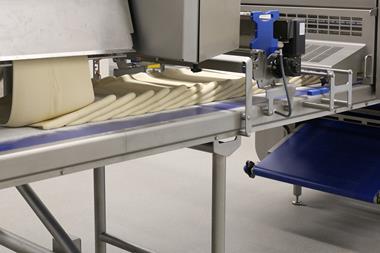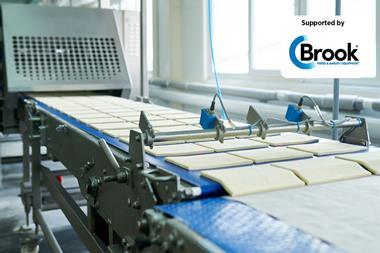Dough and batter temperature are crucial elements in the mixing process – and getting them right can make a huge difference to quality and efficiency.
Temperature control is a key component of dough and batter production. The physical properties of dough and, to a lesser extent batter, change faster as the temperature increases.
“There will be an optimum temperature range that suits a particular style of processing,” says Campden BRI technical development ambassador Gary Tucker.
He points out that a long-fermentation process works best at cool ambient temperatures, while higher dough temperatures and shorter proving times are required by fast industrial processes.
“The role of the mixer includes hydration of dry ingredients, developing the gluten network, and achieving a target dough temperature range that enables the downstream processes to work effectively.”
Dough temperature rises during mixing and, in the case of a fast industrial process, this can sometimes require heat to be removed, particularly in warmer parts of the year. Stanley Cauvain of consultants Baketran points out that provision of chilled or warm water to manage dough temperature is often misjudged because of insufficient water-holding facilities.
“It takes time and energy to cool or warm water before it can be added to the mixer,” he says. “This is especially important in breadmaking as transfer of energy during mixing results in a temperature rise in the dough, which needs to be offset by chilled water to deliver the required temperature.”
To help ensure optimum working levels, mixer suppliers have developed systems such as that used by Baker Perkins’ Tweedy equipment, which blends hot and cold water, and adjusts energy input, to maintain dough temperature.
Large mixers in the Sveba Dahlen range, distributed by Jestic, feature an infrared monitor and temperature probe that combine to monitor the ambient temperature of the dough.
“This is designed to prevent over-mixing and save on energy consumption once the mixer detects the right temperature and, therefore, consistency,” says Jestic national sales manager Richard Norman, adding this helps reduce wastage while making the equipment more energy-efficient.
Energy efficiency is a concern for all businesses, and dough-mixing uses a lot of energy in a short space of time.
As with temperature control, suitable equipment can help a business be more energy-efficient.
Supplier Scobie McIntosh says a bowl that rotates offers clear advantages. Stationary bowls can take 25 minutes to get the dough to the correct mix, while a rotating bowl can reduce this time by half.
Baker Perkins points out that its Tweedy high-speed mixing systems feature short mixing times of small batches – up to 10 batches per hour – and dynamic scheduling.
“A mix does not begin until required downstream, so is much less likely to be aborted and wasted because of unplanned stoppages than with conventional slow-speed mixers,” says Baker Perkins business development manager Keith Graham.
Removing the heat caused by mixing reduces energy efficiency, although Campden BRI points out this is relatively small compared to the energy required to bake bread or cake. Therefore, adds Cauvain, businesses should avoid reducing mixing time in an effort to be more energy-efficient.
“Far more energy is used in baking a product than during mixing, and spending energy baking sub-optimal-quality products is certainly not efficient,” he adds. “Choosing the most appropriate temperature for doughs and batters and delivering them consistently are the key to maximising energy efficiency in the mixer.”
Where should a mixer be ideally located?
Siting a mixer is a major factor in efficiency. Key to siting is the ease with which ingredients can be moved from storage to the mixer, as well as the product from the mixer to the processing line.
Stanley Cauvain of consultants Baketran advises mixers are sited where movements of raw materials to the mixing location and movement of doughs and batter from it are limited, adding that avoiding ‘cross-traffic’ is essential for efficient work flow.
It’s a view echoed by Gary Tucker, technical development ambassador at Campden BRI, who says bread dough is difficult to handle in equipment and on surfaces, and it is more efficient to minimise the distance it travels. He suggests a mixer for batters can be further away from depositing equipment because batter can be pumped through pipes. Tuckers notes that ingredients should also be moved through pipes where possible, allowing the mixer to be sited away from ingredients storage and closer to the processing lines.
“From an engineering perspective, all ingredients should be moved without the need for manual intervention. Flour can be blown through pipes, water and oil pumped, yeast diluted in water so it can also be pumped, and the minor ingredients dissolved or stirred into the solution and pumped,” he explains.
As well as minimising the movement of ingredients and product, plant bakeries should limit movement of mixing bowls.
Equipment supplier Baker Perkins offers the Tweedy mixing system, which avoids this by automatically transferring mixed dough to the divider via a tub hoist. Multivac, meanwhile, is UK agent for Laska mixing equipment, which allows mixers to be located to automatically discharge on to conveyor systems, avoiding the need for manual intervention.
Help with coming clean
Equipment design plays a big role in cleaning and maintaining mixing equipment.
A removable bowl mixer reduces downtime by having additional bowls to aid continuous mixing, says Ann Wells, group marketing at Brook Food Processing Equipment, adding that raised feet allow machines to be swept under easily.
Baker Perkins’ mixers feature a wash attachment and self-clearing drain valve to aid cleaning of the mixing bowl and lid, while the ingredients platform includes a fully drained washdown area for liquid ingredients.
Sveba Dahlen mixers have bowls with drain plugs to help empty the machine after cleaning, as well as stainless-steel exteriors and quick-change systems for tools to help speed cleaning.






























No comments yet